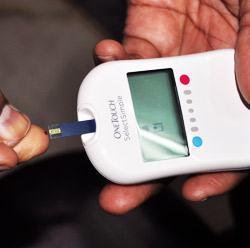
World Diabetes Day is being celebrated on November 14 of each year. The primary objective of celebrating diabetes day is to increase the awareness about the effects and complications of diabetes amongst the general population. This also aims to make the people aware of several aspects of diabetes including information on its symptoms, diagnosis, treatment, and more.
Diabetes is a condition characterized by the body's inability to convert food into energy properly. It is the common name for a range of conditions that includes diabetes mellitus type one and diabetes mellitus type two, diabetes insipidus and gestational diabetes. These are the diabetic conditions, that are affected mainly by the two factors: how the pancreas secretes insulin in the body or how the body reacts to this hormone. The depending on the type and severity, diabetes is controlled by several dietary measures, weight loss, oral medication or injected or inhaled insulin. There is a number of short and long-term complications related to diabetes including foot, eyes and vascular problems.
On December 20, 2006, the United Nations first passed a resolution according to which November 14 was designated as World Diabetes Day. World Diabetes Day was first commemorated on November 14, 2007 and is observed annually. This World Diabetes Day campaign is governed by the International Diabetes Federation and has its members around the world. The member association of International Diabetes Federation includes, the American Diabetes Association, Diabetes UK, Diabetes Australia, the Canadian Diabetes Association, Diabetes South Africa, Diabetes New Zealand and the Diabetic Association of India. These organizations are responsible for arranging various events at international, national and local levels.
The occasion of celebrating world diabetes day is focused to raise the awareness of diabetes its causes, its prevention and related complications. Governments, NGOs and private businesses are encouraged to increase awareness of diabetes, among the general population and the media.
According to a latest statistics revealed by The International Diabetes Federation (IDF), one in 10 adults could have diabetes by 2030, according to their latest statistics. It is estimated that 522 million people would suffer from diabetes in the next two decades, due to things like demographic changes and aging. World Health Organization (WHO) has also supported the prediction made by International Diabetes Federation and has mentioned in a report issued by it that the number of diabetic patients will get doubled by 2030.World Health Organization, has issued a data that tells that there are about 346 million people across the world with diabetes, among which more than 80 percent of deaths occurring in developing countries.
World Diabetes day is symbolized by blue circle and celebrated across the world with an objective to bring awareness among the common people so that they many get the true knowledge of the causes, symptoms, prevention and cure of diabetes. For this, last year in 2010, over 900 monuments and buildings in 84 countries were lit in blue on 14 November to raise awareness of diabetes and World Diabetes Day. The story will be continued in 2011 also as International Diabetes Federation (IDF) is encouraging everyone to use blood lightings as a symbol of World diabetes day.
Diabetes is now a global concern and hence almost all the countries are participating in World Diabetes Day today. Several researches in all the medical sciences are being carried in all parts of the world for the treatment of diabetes on a large scale. The ancient traditional medicinal science, Ayurveda provides a range of remedies for the treatment of diabetes
Diabetes: An Ayurvedic View
In Ayurveda, diabetes is considered to be a kapha disorder, in which declining activity of agni in the body can lead to increase in blood sugar resulting in diabetes. In Ayurveda 24 types of diabetes has been mentioned ot of which 4 are caused by Vata dosha, 6 are caused by Pitta dosha, and remaining 10 due to Kapha dosha. Many approaches has been described in ayurveda for the treatment of diabetes that includes diet , lifestyle , Panchakarma and herbs.
Diet
Ayurveda suggests a balanced diet and reduce the intake of sugar and complex carbohydrates. However, it recommends the intake of the complex carbohydrates. The intake of protein should be reduced as they can damage the kidneys. Similarly, consumption of fatty oils should also be limited. It is recommended to eat plenty of fresh vegetables, orange, lemons, bitter fruits and herbs.
Panchakarma
Many diabetic patients contains antibodies against their own pancreatic tissues called auto antibodies. Panchkarma helps in cleaning these auto antibodies from the body. Panchkarma includes several therapies like herbal massages, herbal steam sauna, and fasting.
Herbs
In ayurveda, several herbs are mentioned that are very effective in the the treatment of diabetes. Herbs such as Shilajit, gudmar turmeric, neem, amalaki, guggul, and arjuna are considered to be the best ayurvedic treatment for diabetes. Turmeric along with aloe-vera gel is effective in the early stages of diabetes for regulating function of pancreas and liver.
Exercise and Yoga
Doing yoga and exercise are quite beneficial for the prevention and treatment of diabetes.
Diabetes is now a common problem faced by a large number of population all over the world. Though number of diabetes treatments in form of pills and injections, are available today , only Ayurveda is the perfect solution for the prevention and treatment of diabetes as it promises the cure of the disease from the root level on a permanent basis.
Read More on Ayurveda Remedies and Treatment of diabetes.
|
|


Comments: